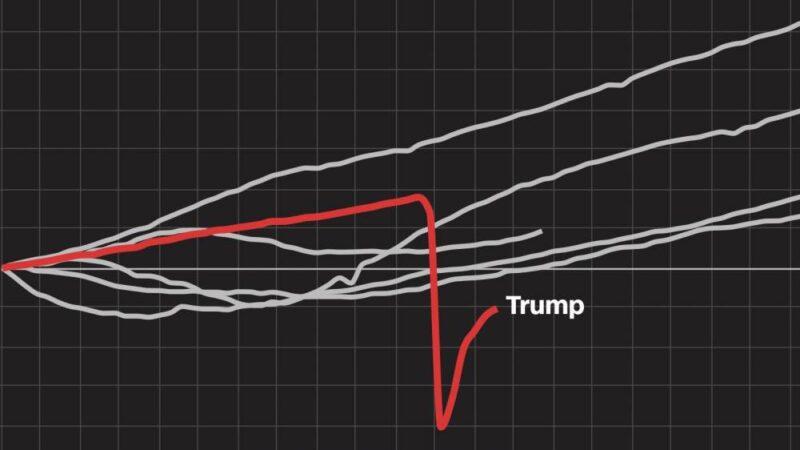GDP Report: Trump is taking credit for the ‘biggest and best’ GDP in American history. Here are the facts
New York (CNN Business)The US government just published an eye-popping report: Gross domestic product, the broadest measure of the country’s economic growth, grew at a stunning 33.1% annual rate in the third quarter.
President Donald Trump was quick to celebrate: “GDP number just announced. Biggest and Best in the History of our Country, and not even close. Next year will be FANTASTIC!!!” he wrote on Twitter. “So glad this great GDP number came out before November 3rd.” His campaign also activated a flurry of Facebook ads, touting “fastest GDP growth in history,” “the great American comeback” and a “surging” economy.
But is the economy really the “biggest and best”? Here are the facts:
1. Historic gains follow record-breaking losses
Read MoreIt’s true that third-quarter growth was the fastest on record in data going back to 1947. (See the full data set here.) But celebrating that number is like telling only half the story.It’s impossible to ignore what happened immediately leading up to those gains: The US economy declined at a 31.4% annual rate — the deepest downturn on record. A big reason the US posted record GDP this quarter is because there was a record decline in the prior quarter.When you step back and look at that broader context, the US economy is still operating well below its pre-pandemic peak. Gross domestic product is still $670 billion lower than where it was at the end of 2019. The chart below tells that story more clearly than any words can. (See the full data here.)
2. Real-time data show the recovery has slowed
It’s absolutely good news that the recovery has begun. Those gains represent real value to the businesses that have been revived, and paychecks for workers who went back to their jobs. But here’s the bad news: we already know the speedy recovery stalled in the fall.Real-time data show economic activity has lost momentum recently. Job growth has slowed, as have declines in unemployment claims.

Interactive: These 10 charts show how the economy performed under Trump versus prior presidents
That’s in part because the sugar rush from stimulus funds has worn off. Earlier in the pandemic, $1,200 checks from the government and a temporary $600 boost in weekly unemployment benefits helped many families weather the crisis. And loans from the Paycheck Protection Program aided businesses. Those efforts initially helped fuel the recovery over the summer, but now, Congress is at an impasse on further stimulus funds. Now, coronavirus cases are surging again, posing a greater public health risk, as well as an economic one. Given those challenges, it’s unlikely the economy will fully recover by the end of the year, economists say.
3. People and businesses are still hurting
Dig into specific sectors, and it’s not hard to see that economic pain persists.Restaurants, as tracked by OpenTable data, are seating only about half the diners they seated in early March. Travelers processed through TSA checkpoints are still down more than 50% from a year ago. Hotel occupancy, tracked by STR, is down 31% from a year ago.

INTERACTIVE: Track America’s recovery — from your job to your investments
Box office sales, as tracked by Box Office Mojo are less than a tenth of their pre-pandemic norms. Hours worked by employees at small businesses, as tracked by Homebase, are still more than 20% below their level in early March. The Back-to-Normal Index, created by CNN Business and Moody’s Analytics, includes many of these metrics and shows overall, economic activity has barely changed in the last month.If you worked at a restaurant, airline, movie theater, hotel or small business — you probably don’t need data, though, to tell you that. Jobs in these industries have yet to recover.Meanwhile, some companies are just starting a fresh wave of layoffs. Disney (DIS), United Airlines (UAL), American Airlines (AAL) and Charles Schwab (SCHW) have announced mass job cuts.Millions of families continue to struggle with food insecurity, according to data collected through the Census Pulse survey. As of mid October, 23 million households didn’t have enough to eat either “sometimes” or “often” over the course of a week, up from 14 million prior to when the pandemic struck in early March.And as of last week, 7.8 million Americans filed for their second week or more of unemployment benefits.
But just as he’s done with the GDP figures, Trump frequently tells only half the story about the job market, too. At campaign stops this month, he has touted a record 11.4 million job gains since May as a sign of economic strength. The full story, however, is this: Before that hiring took place, employers slashed 22 million jobs in March and April. Do the math, and the economy is still down more than 10 million jobs over the course of the pandemic. (See the full data here)Or in other words, the recovery is far from complete.
Source: edition.cnn.com

